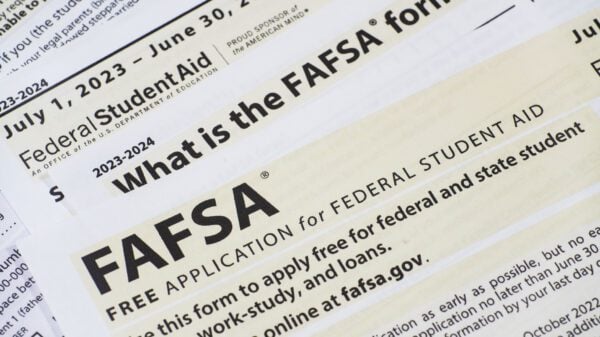Indiana leaders this week welcomed an order from President Donald Trump intended to close the U.S. Department of Education, saying it will give the state more control over education and greater flexibility to spend federal funds.
The long-expected step directs Secretary of Education Linda McMahon to “take all necessary steps to facilitate the closure of the Department of Education and return authority over education to the States and local communities” in order to save money and improve academic outcomes.
Both Indiana Gov. Mike Braun and Secretary of Education Katie Jenner expressed support for the move, with Jenner writing in her weekly newsletter Friday that it would “empower Hoosier communities to identify and respond to the unique needs of our students.”
“Hoosiers know what our students need to succeed better than bureaucrats in D.C.,” said Braun in a post on X.
But how the order and other presidential actions will ultimately affect students with disabilities, those learning English, and even college graduates paying back student loans remains to be seen, as advocates fear major disruptions in programs and services. Trump further announced Friday that the Small Business Administration would handle student loans, and that the Department of Health and Human Services would oversee students with disabilities.
Only an act of Congress could close the department completely. But experts say the order — combined with the layoffs and buyouts that have already affected critical areas of the department — could dismantle some key functions, leading to far-reaching consequences for students and teachers.
“It’s a broad strokes order creating chaos and taking away resources so that the Department of Education will no longer be functional even if there is a department going forward,” said Brooke Kandel, dean of Butler University’s College of Education.

Future for K-12 students is uncertain
What happens next will vary in each state and depending on how Congress acts, Kandel said. The order is not likely to affect curriculum in states and schools, which was already largely a local decision.
One of the Education Department’s key functions is distributing billions of dollars in education funding, especially the funding schools rely on to educate students who come from low-income backgrounds or those who receive special education services. Much early speculation has focused on how its funds would be allocated if the department were dissolved.
Indiana is one of 12 states to ask McMahon for “maximum flexibility” in receiving and spending federal funds. This could mean allowing states and districts to receive all their federal Title funds in block grants, said Jenner and 11 other state education officials in a January letter.
Their other suggestions included implementing “alternative spending approaches” such as competitive or matching grants for allocating Title I funds — which support students from low-income backgrounds, among others.
They also asked McMahon to allow states to “define how districts allocate funds at the school level, particularly when education goals are not being met.”
“By reducing federal constraints on funding streams, [state education agencies] can more effectively address their unique challenges, such as rural school support, achievement gaps, and workforce alignment,” the joint letter said.
But since Title funding currently supports specific initiatives and student groups, redirecting it could mean the loss of programs or services in areas such as special education or English learner education, Kandel said.
And the effects could compound. Cuts to the statistics arm of the department would mean the loss of national data sets.
Cuts to the Office for Civil Rights make the department less able to respond to families’ concerns about discrimination against students based on disability, race, or gender, she added. Under Trump, the focus of the OCR has shifted to focus on states, districts, and universities that it says are promoting DEI policies and are violating Title IX, a federal law that prohibits sex discrimination, by allowing gender-neutral bathrooms and trans athletes to compete in women’s sports.
“You need people to investigate possibilities of discrimination, and if you don’t have the staff you just can’t follow through with those, ” Kandel said. “We need to keep states and schools accountable to students and be consistent with how we apply laws to students.”
In comments during the order signing, Trump said funds for special education and high-poverty schools would be preserved. Rewriting the way federal funds for education are allocated would also require an act of Congress.
In a statement on potential cuts to education programs, the Indiana Department of Education said, “We are not currently aware of any federal funding cuts that will impact programs administered by the Indiana Department of Education.”
“Education is a state and local responsibility. Governor Braun supports efforts to return control over education to its proper place. He is confident in Indiana’s ability to provide an excellent K-12 education for Hoosier students,” the statement said.

Impact on college-going students
Coming off a year of persistent glitches and delayed aid notices, this year’s FAFSA – Federal Application for Free Student Aid – now faces questions from students and families about cuts and changes at the Education Department as well as about future loan repayment.
“We want to make sure that people don’t walk away” from aid dollars or from going to college in general, said William Wozniak, INVestED vice president and CMO. INvestED provides free FAFSA help across the state both in-person and via phone.
The biggest thing to know is “the FAFSA is open and financial aid is out there,” he said.
Wozniak stressed that despite the form’s name, it’s not just for federal funds, but also for state and university-based scholarships and funds.
That includes state funds like 21st Century Scholars and Frank O’Bannon Grant. The FAFSA website also notes that direct loans and Pell Grants are still available.
And award letters from universities are going out, Wozniak said.
While the form is working, the piece with more uncertainty is student loan debt and the future of repayment plans given ongoing court cases, he said.
So Wozniak’s advice to students and families is to fill out the FAFSA, see what’s available to them, and then make decisions about what aid to use.
“Let’s do everything we can on the front end to get all the financial aid we can to minimize debt,” he said. “That’s what we can 100% control.”
What things look like in four years is impossible to predict, he said, but students have control over looking at strategies to graduate with the least amount of debt.
The deadline to fill out the FAFSA for state aid is April 15. Indiana students are required to fill out the form, however there are some exceptions and it is not a requirement to graduate.
Aleksandra Appleton covers Indiana education policy and writes about K-12 schools across the state. Contact her at aappleton@chalkbeat.org.
MJ Slaby oversees Chalkbeat Indiana’s coverage as bureau chief. Contact MJ at mslaby@chalkbeat.org.
Chalkbeat is a nonprofit news site covering educational change in public schools.




